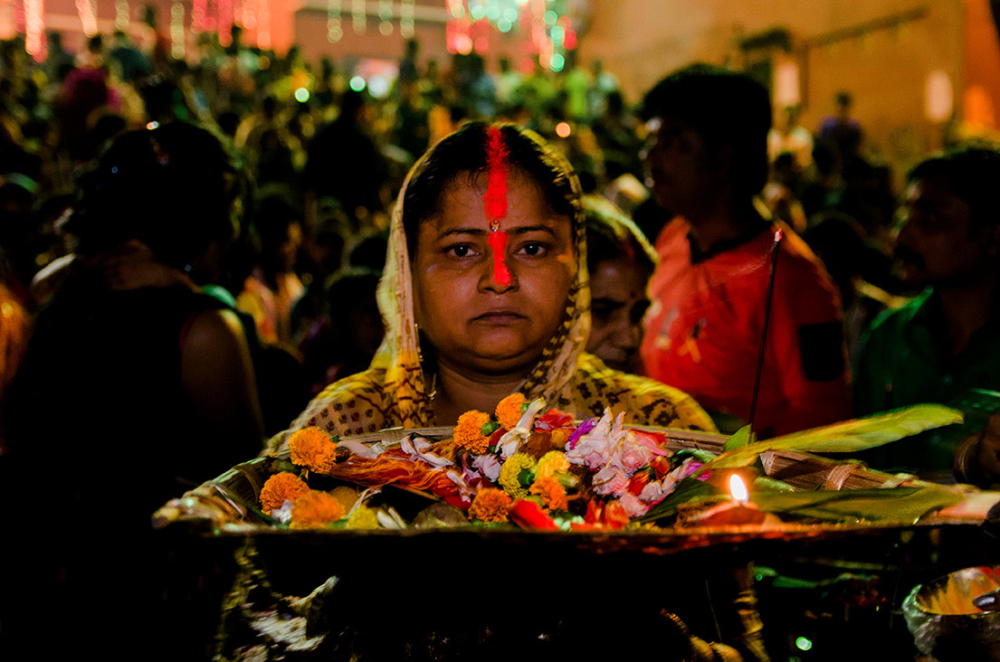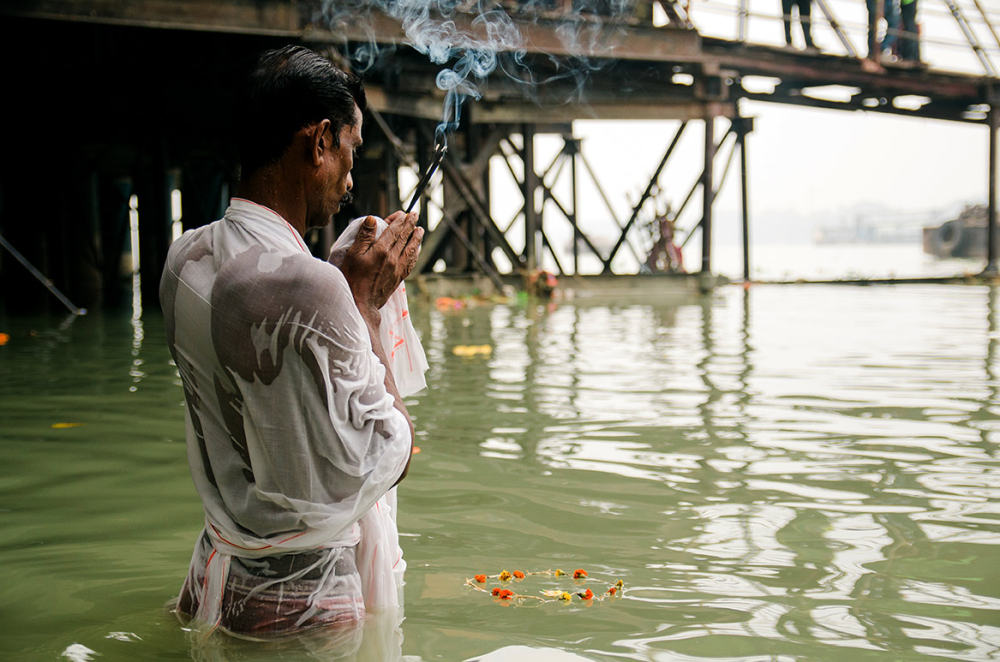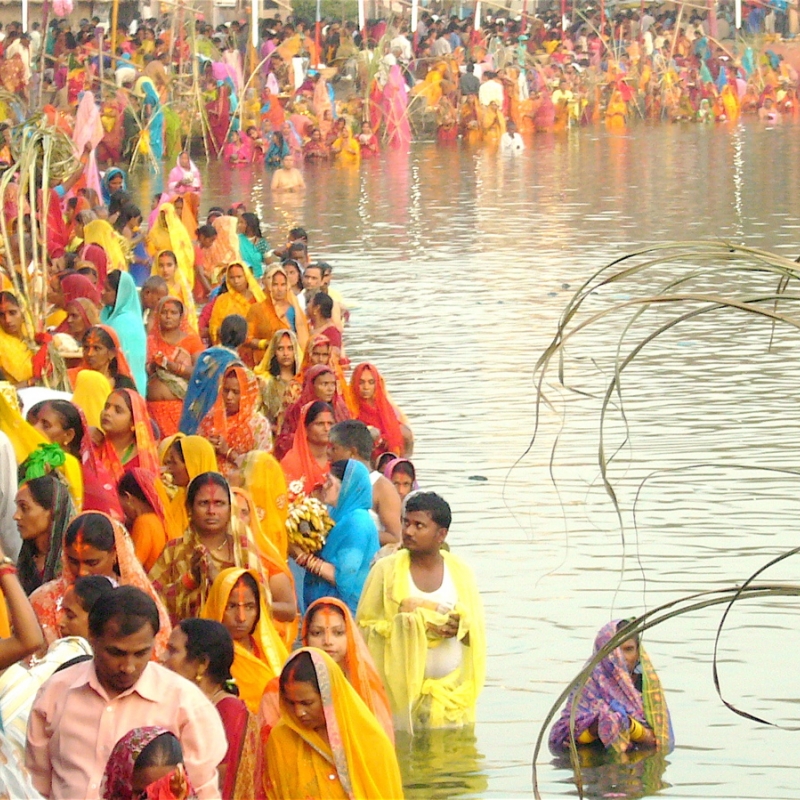Chhath Puja has evolved into a popular solar festival, and is celebrated with fervour across north and east India. While it’s classified as a solar festival, Chhathi Mai, wife/consort of the Indian sun god, Surya, is worshipped as well. We explore the legends and myths around the origins of this festival (Photo Source: Steffen Gauger/Wikimedia Commons)
Chhath Puja has its origins in the Indian states of Bihar, Jharkhand and Chhattisgarh, and in Nepal, but its popularity has now spread not only across north and east India, but even across the world. The four-day celebrations attract so many people that city and state authorities often have to make special arrangements.
Celebrated six days after Diwali, Chhath Puja falls in the lunisolar month of Kartik (October-November of the Gregorian calendar). It’s often referred to as a solar festival since the principal god is Surya, the sun god; it is called Surya Shasthi Vrat, with the word chhat coming from shasthi or the sixth day of the new moon. The goddess Chhathi Mai/Usha, said to be Surya’s consort, holds a significant position of reverence and worship. Interestingly, this is one of the few solar festivals that start at sunset rather than sunrise. This is not a gender-specific festival, but has traditionally and socially been female-centric, partly also because Chhathi Mai is said to be the protector goddess of children, ensuring their longevity and good health.
But who is Chhathi Mai? As the name suggests, six is a crucial element in the story. 'According to the Brahmavaivarta Purana, when God created the world, He also created the duality of Purusha and Prakriti. Prakriti was then further divided into several elements, of which the sixth part is Chhathi/Shasthi… She is called Devasena,' says Pradyumna Kumar, an award-winning Madhubani artist, who has extensively researched Chhath Puja. (Click here for an image gallery of Chhath Puja rituals being performed.)
The Story of Devasena

Chhath Puja is not a gender-specific festival, but has traditionally and socially been female-centric, partly also because Chhathi Mai is said to be the protector goddess of children, ensuring their longevity and good health (Photo source: Arnab Bhaumik/Sahapedia.org)
Kumar goes on to recount the story of how Devasena came to be associated with children. 'There were a king Priyavrat and his queen Malini, most likely in the belt around current Bihar and Jharkhand. They did not have any children and conducted a Putrakaamesthi Yagya (a ritual requesting the gods to bestow them with a son), during which a bowl of kheer (rice pudding) appeared from within the havan kund (fire pit). The queen eats the pudding and becomes pregnant. However, the child is stillborn. Grief-stricken, she rushes to a river to commit suicide when a woman appears and stops her. Identifying herself as Devasena/Shasthi, she asks the queen to worship her and the sun god, for bestowing children and for their protection. Queen Malini did as asked, and was soon blessed with a child. Since then, the practice of Chhath Puja started.'
Perpetuating the Lineage
Another reference to Chhathi Mai as the giver and protector of children comes in K.S. Singh’s paper Solar Traditions in Tribal and Folk Cultures of India. He writes: 'The kathas, as they are recited today, also bear evidence of the influence of many other cults, such as that of the mother goddess who is called Chhathi Mai. The influence of the mother goddess cult on Chhath may have appeared later. It is explained through myths. Devi, it is said, was born in Bihar to restore happiness after the great battle between the Asurs and Devas. She is the giver of children and their protector. She ensures the perpetuation of lineage (vansha) by granting the boon of having sons. The anthropomorphic representation of Chhathi Mai has been a recent innovation. The essential characteristics of the Chhath as the festival centred on sun worship, however, remain intact.'
Click here for a video on Chhath Puja rituals.
Devasena and Kartik
While Chhathi has often been referred to as Surya’s consort, there is a mention of Devasena in the Brahmavaivarta Purana as Kartik’s wife. In Ganesh: Studies of an Asian God, Robert L Brown quotes from the Ganesa Khanda: 'Narada interrupts his narrative of the birth and early life of Ganesa to describe the origin of Kartika. Kama gives "the knowledge of the sexual science" to Kartika; after this "Brahma chanted the Vedas and married the fair, lovely, good-natured Devasena (whom the savants caked Sasthi) to Kartika".’ Brown says this description suggests a sexual union between Devasena and Kartik.
Chhath Puja in the Ramayana and Mahabharata

In the Mahabharata, Kumar says, ahead of the Kurukshetra war, Surya’s son Karna performed some of the rituals that are now a part of Chhath Puja (Photo source: Arnab Bhaumik/Sahapedia.org)
Like many popular Indian rituals and festivals, the Chhath Puja too is referenced in the two epics of Ramayana and Mahabharata. According to Kumar, in the Ramayana, Sita and Rama performed the ritual after their return from exile, when Rama was advised to atone for killing Ravana, a Brahmin. Local people in Munger, Bihar, believe Sita performed the Chhath vrat (ritual) there. They say that Sita Charan Mandir, a temple with impressions of Sita’s feet, stands testimony to this lore.
In the Mahabharata, Kumar says, ahead of the Kurukshetra war, Surya’s son Karna performed some of the rituals that are now a part of Chhath Puja. Later, Draupadi and the Pandavas performed similar rituals to win back their kingdom.
Chhath Puja and Post-Harvest Gratitude
Apart from the popular lore associated with Chhath Puja, the festival also has a connection with agriculture. This can be classified as a post-harvest festival, as the worship of the sun is a show of gratitude for the bountiful harvest in the season just ended, rice being one of the crops harvested at this time.
In this article, we’ve discussed the various mythological stories and folklore associated with Chhath Puja and its presiding deity Chhathi Mai. We will explore the various rites and rituals of the festival in a future piece.













